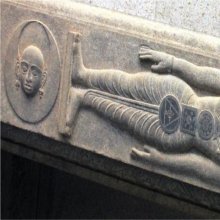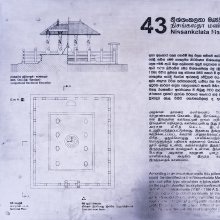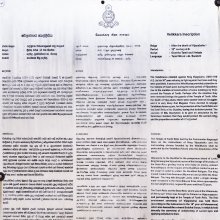Ida, Iḍā, Idā, Īḍā: 24 definitions
Introduction:
Ida means something in Hinduism, Sanskrit, Buddhism, Pali, Marathi, Jainism, Prakrit, Hindi, biology. If you want to know the exact meaning, history, etymology or English translation of this term then check out the descriptions on this page. Add your comment or reference to a book if you want to contribute to this summary article.
Alternative spellings of this word include Eid.
Images (photo gallery)
In Hinduism
Purana and Itihasa (epic history)
Source: archive.org: Puranic Encyclopedia1) Iḍā (इडा).—Daughter of Vāyu (wind-god). Iḍā had a son Utkala by Dhruva.
2) Iḍā (इडा).—Daughter of Manu. In Taittirīya Brāhmaṇa, we find the following reference to this Iḍā:—
2) Once Manu came to know that Devas and Asuras had performed an Agnyādhāna (consecration of the fire). To ascertain whether it was deposited at the proper time, Manu sent Iḍā to them. Iḍā found that both parties had followed the wrong method, She said to Manu:—"Your yajña (Agnyādhāna) should not be as ineffectual as that of the Devas and Asuras. Therefore I myself shall deposit the Trividhāgnis (the three Agnis which are to be set in the proper place) at the proper place." Manu agreed and began his yāga. As a result of it the Devas attained plenty and prosperity.
2) Once when Iḍā was in the presence of Manu. the Devas invited her openly and the Asuras invited her covertly. Since Iḍā accepted the invitation of the Devas, all creatures abandoned the Asuras and joined the party of Devas. (Taittirīya Saṃhitā).
Source: Cologne Digital Sanskrit Dictionaries: The Purana Index1a) Iḍā (इडा).—See ilā.*
- * Brahmāṇḍa-purāṇa III. 60. 11; Vāyu-purāṇa 85. 7.
1b) A śakti of Māruta.*
- * Brahmāṇḍa-purāṇa IV. 33. 70.

The Purana (पुराण, purāṇas) refers to Sanskrit literature preserving ancient India’s vast cultural history, including historical legends, religious ceremonies, various arts and sciences. The eighteen mahapuranas total over 400,000 shlokas (metrical couplets) and date to at least several centuries BCE.
Shaktism (Shakta philosophy)
Source: Google Books: ManthanabhairavatantramIḍā (इडा) refers to one of the three channels (of vital breath) in the body hosting the deities Vāmā and Brahmā.—In the Tantrasadbhāva we find the geometric shapes related to the energies, or aspects of the one energy, that constitute the Triangle. [...] These three energies are the consorts of the gods Brahmā, Viṣṇu and Maheśvara and manifest as a series of triads. At the microcosmic level they engender exhalation (equivalent to creation brought about by Vāmā), inhalation (equivalent to persistence brought about by Jyeṣṭhā) and retention of the breath (equivalent to withdrawal brought about by Raudrī). They are located in the corresponding channels in the body where these three forms of the vital breath function: namely Iḍā, Piṅgalā and Suṣumṇā, respectively. [...]”.
Source: academia.edu: The Śāradātilakatantra on YogaIḍā (इडा) refers to the “left principle channel” and is explained in terms of kuṇḍalinīyoga by Lakṣmaṇadeśika in his 11th-century Śaradātilaka.—The body is described, starting from the “bulb” (kanda), the place in which the subtle channels (nāḍī) originate, located between anus and penis (28–9). The three principal channels are iḍā (left), piṅgalā (right) and suṣumṇā (in the centre of the spine and the head). Inside the suṣumṇā is citrā, a channel connecting to the place on the top of the skull called the brahmarandhra (30–4).
Source: Kamakoti Mandali: The Yoginis of Narasimha VyuhaIḍā (इडा) is the name of a Mātṛkā-Śakti created by Mahārudra in order to control the plague of demons created by Andhakāsura.—Accordingly, Andhaka-Asura tried to kidnap Umā (Devī Pārvatī), and was fiercely attacked by Mahārudra who shot arrows at him from his mahāpināka. when the arrows pierced the body of Andhakāsura, drops of blood fell to earth and from those drops, thousands of Andhakas arose. To control this plague of demons, Mahārudra created Mātṛkā-Śaktis [viz., Iḍā] and ordered them to drink the blood of the demons and drain them dry.
Source: Kamakoti Mandali: Nrisimha matrika-mandalaIḍā (इडा) refers to one of the various Mātṛkā-Śaktis created by Rudra in order to destroy the clones that spawned from Andhaka’s body.—Accordingly, [...] Andhakāsura attempted to abduct Girājanandinī (Pārvatī) and thus ensued a fierce battle between Andhakāsura and the great Rudra, the Lord of Umā. Like raktabīja, every drop of blood that fell from the body of Andhaka created another Asura like him and in no time, the entire world was filled with Andhakas. To destroy the growing number of Andhakas, Rudra created innumerable Mātṛkā-Śaktis [viz., Iḍā]. These Śaktis of immense power at once began to drink every drop of blood that flowed from the body of Andhaka, but they could still not effectively contain the emergence of more and more demons.

Shakta (शाक्त, śākta) or Shaktism (śāktism) represents a tradition of Hinduism where the Goddess (Devi) is revered and worshipped. Shakta literature includes a range of scriptures, including various Agamas and Tantras, although its roots may be traced back to the Vedas.
Ayurveda (science of life)
Nighantu (Synonyms and Characteristics of Drugs and technical terms)
Source: Wisdom Library: Raj NighantuIḍā (इडा) refers to “earth” and is mentioned in a list of 53 synonyms for dharaṇi (“earth”), according to the second chapter (dharaṇyādi-varga) of the 13th-century Raj Nighantu or Rājanighaṇṭu (an Ayurvedic encyclopedia). The Dharaṇyādi-varga covers the lands, soil [viz., Iḍā], mountains, jungles and vegetation’s relations between trees and plants and substances, with their various kinds.

Āyurveda (आयुर्वेद, ayurveda) is a branch of Indian science dealing with medicine, herbalism, taxology, anatomy, surgery, alchemy and related topics. Traditional practice of Āyurveda in ancient India dates back to at least the first millenium BC. Literature is commonly written in Sanskrit using various poetic metres.
Biology (plants and animals)
Source: Google Books: CRC World Dictionary (Regional names)1) Ida in India is the name of a plant defined with Citrus aurantium in various botanical sources. This page contains potential references in Ayurveda, modern medicine, and other folk traditions or local practices It has the synonym Aurantium acre Mill. (among others).
2) Ida in Nigeria is also identified with Sorghum bicolor It has the synonym Milium nigricans Ruiz & Pav. (etc.).
3) Ida in Yoruba is also identified with Microsorum punctatum It has the synonym Phymatodes irioides (Poir.) C. Presl (etc.).
Example references for further research on medicinal uses or toxicity (see latin names for full list):
· Enumeratio Plantarum Javae (1828)
· Methodus Plantas Horti Botanici … (1794)
· Caryologia (1985)
· Austral. Syst. Bot. (2002)
· Observationes Botanicae (1781)
· Icones plantarum formosanarum nec non et contributiones ad floram formosanam. (1915)
If you are looking for specific details regarding Ida, for example pregnancy safety, diet and recipes, health benefits, side effects, chemical composition, extract dosage, have a look at these references.

This sections includes definitions from the five kingdoms of living things: Animals, Plants, Fungi, Protists and Monera. It will include both the official binomial nomenclature (scientific names usually in Latin) as well as regional spellings and variants.
Languages of India and abroad
Pali-English dictionary
Source: Sutta: The Pali Text Society's Pali-English DictionaryIda, & Idaṃ (indecl.) (nt. of ayaṃ (idaṃ) in function of a deictic part.) emphatic demonstr. adv. in local, temporal & modal function, as (1) in this, here: idappaccayatā having its foundation in this, i.e. causally connected, by way of cause Vin.I, 5 = S.I, 136; D.I, 185; Dhs.1004, 1061; Vbh.340, 362, 365; Vism.518; etc.—(2) now, then which idha is more frequent) D.II, 267, 270, almost syn. (for with kira.—(3) just (this), even so, only: idam-atthika just sufficient, proper, right Th.1, 984 (cīvara); Pug.69 (read so for °maṭṭhika, see Pug.A 250); as idam-atthitā “being satisfied with what is sufficient” at Vism.81: expld. as atthika-bhāva at Pug.A 250. idaṃsaccâbhinivesa inclination to say: only this is the truth, i.e. inclination to dogmatise, one of the four kāya-ganthā, viz. abhijjhā, byāpāda, sīlabbata-parāmāsa, idaṃ° (see Dhs.1135 & Dhs.trsl. 304); D.III, 230; S.V, 59; Nd1 98; Nett 115 sq. (Page 120)

Pali is the language of the Tipiṭaka, which is the sacred canon of Theravāda Buddhism and contains much of the Buddha’s speech. Closeley related to Sanskrit, both languages are used interchangeably between religions.
Marathi-English dictionary
Source: DDSA: The Molesworth Marathi and English Dictionaryiḍā (इडा).—m S A certain tubular vessel, one of the (kṣvāsācyā nāḍyā) channels of the Vital spirit. In the anatomy of the Yoga school are particularized three great passages of the breath and air running from Os coccygis to the head. Of these iḍā is the passage on the right side, proceeding through (or springing from) the nābhicakra or um- bilical region and through the nose; piṅgaḷā that on the left; suṣumnāmnā ascends betwixt the two, entering into the middle of the head. Ex. iḍā āṇi piṅgaḷā vāhatī vōgha dōnhī || ahaṃ sōhaṃ smaraṇī nitya cālē || See ex. under suṣumnāmnā.
--- OR ---
īḍa (ईड).—f (S) The Lime-tree. 2 n also īḍalimbūṃ n A lime, Citrus limonum.
--- OR ---
īda (ईद).—f ( A) Any Muhammadan festival or solemnity. 2 m f A common term for the great festivals (makarasaṅkrānti, divāḷī, dasarā &c.) occurring in the first year after the marriage of a couple: on which they send to each other presents of sesamum, coarse sugar &c.: also such presents.
Source: DDSA: The Aryabhusan school dictionary, Marathi-Englishiḍa (इड).—f The lime-tree; also īḍalimbū n A lime.
--- OR ---
īda (ईद).—f Any Muhammedan festival or solemnity.
Marathi is an Indo-European language having over 70 million native speakers people in (predominantly) Maharashtra India. Marathi, like many other Indo-Aryan languages, evolved from early forms of Prakrit, which itself is a subset of Sanskrit, one of the most ancient languages of the world.
Sanskrit dictionary
Source: DDSA: The practical Sanskrit-English dictionaryIḍa (इड).—An epithet of Agni.
Derivable forms: iḍaḥ (इडः).
--- OR ---
Iḍā (इडा).—[il-ac, vā lasya ḍatvam]
1) The earth; प्रवुध्यते नूनमिडातलस्थः (pravudhyate nūnamiḍātalasthaḥ) Mb.
2) Speech.
3) An offering, libation (coming between prayāja and anuyāja); अग्निश्चते योनिरिडा च देहः (agniścate yoniriḍā ca dehaḥ) Mahābhārata (Bombay) 3.114.28.
4) Refreshing draught.
5) (Hence) Food.
6) (Fig.) Stream or flow of praise or worship personified as the goddess of sacred speech; इडोपहूताः क्रोशन्ति कुञ्जरास्त्वङ्कुशेरिताः (iḍopahūtāḥ krośanti kuñjarāstvaṅkuśeritāḥ) Mahābhārata (Bombay) 12.98.26.
7) Libation and offering of milk.
8) A cow. इडेरन्ते (iḍerante) &c. ŚB. on MS. 1.3.49.
9) Name of a goddess, daughter of Manu. (She is the wife of Budha and mother of Purūravas; she is also called maitrāvaruṇī as the daughter of mitra and varuṇa).
1) Name of Durgā
11) Heaven.
12) A tubular vessel (nāḍībheda), (being in the right side of the body).
See also (synonyms): ilā.
--- OR ---
Idā (इदा).—ind. Now, at this (present) moment; oft. with अहन् (ahan); इदाचिदह्नः (idācidahnaḥ); इदा ह्यः (idā hyaḥ) only yesterday.
--- OR ---
Īḍā (ईडा).—[īḍ-a-ṭāp] Praise, commendation.
Source: Cologne Digital Sanskrit Dictionaries: Shabda-Sagara Sanskrit-English DictionaryIḍā (इडा).—f.
(-ḍā) 1. The wife of Buddha, daughter of Ikshaku. 2. The earth. 3. A cow. 4. Speed. 5. A tubular vessel, one of the principal channels of the vital spirit, that which is on the right side of the body. 6. Heaven. 7. The goddess of speech. E. il to direct or send, ka affix, and ṭāp fem. la and ḍa are interchangeable: see ilā.
--- OR ---
Īḍā (ईडा).—f.
(-ḍā) Praise. E. īḍ to praise, ka and ṭāpa affs.
Source: Cologne Digital Sanskrit Dictionaries: Benfey Sanskrit-English DictionaryIḍā (इडा).— (akin to īḍ), f. 1. Refreshment, ved.
Iḍa (इड).—[masculine] [Epithet] of Agni; [Name] of a king.
--- OR ---
Iḍā (इडा).—[feminine] = iḍ + speech, earth, cow; [Name] of a goddess (personif. of worship and sacrifice), a daughter of Manu or Dakṣa, [Epithet] of Durgā.
--- OR ---
Idā (इदा).—[adverb] now, this moment; [with] ahnas this very day; [with] hyas only yesterday.
Source: Cologne Digital Sanskrit Dictionaries: Monier-Williams Sanskrit-English Dictionary1) Iḍa (इड):—[from iḍ] m. Name of Agni (who is to be addressed with prayers, or invoked with the stream of flow of praise), [Vājasaneyi-saṃhitā ii, 3]
2) [v.s. ...] Name of a king (a son of Kardama or Manu), [Viṣṇu-purāṇa] (cf. ila.)
3) Iḍā (इडा):—[from iḍ] f. or (in Ṛg-veda) iLā, (not to be confounded with the inst. case of iḍ above), refreshing draught, refreshment, animation, recreation, comfort, vital spirit, [Ṛg-veda; Atharva-veda; Aitareya-brāhmaṇa]
4) [v.s. ...] offering, libation (especially a holy libation, offered between the Pra-yāga and Anu-yāga, and consisting of four preparations of milk, poured into a vessel containing water, and then partially drunk by the priest and sacrificers; personified in the cow, the symbol of feeding, and nourishment), [Śatapatha-brāhmaṇa i, 8, 1, 1, etc.; Aitareya-brāhmaṇa; Kātyāyana-śrauta-sūtra; Kauśika-sūtra]
5) [v.s. ...] (metaphorically cf. id), stream or flow of praise and worship (personified as the goddess of sacred speech and action, invoked together with Aditi and other deities, but especially in the Āprī hymns together with Sarasvatī and Mahī or Bhāratī), [Ṛg-veda; Atharva-veda; Vājasaneyi-saṃhitā] etc.
6) [v.s. ...] the earth, food, [Sāyaṇa]
7) [v.s. ...] a cow
8) [v.s. ...] the goddess iḍā or iLā (daughter of Manu or of man thinking on and worshipping the gods; she is the wife of Budha and mother of Purū-ravas; in another aspect she is called Maitrāvaruṇi as daughter of Mitra-Varuṇa, two gods who were objects of the highest and most spiritual devotion)
9) [v.s. ...] Name of Durgā
10) [v.s. ...] of a daughter of Dakṣa and wife of Kaśyapa
11) [v.s. ...] of a wife of Vasudeva and of the Rudra Ṛta-dhvaja
12) [v.s. ...] speech, [Bhāgavata-purāṇa]
13) [v.s. ...] heaven, [cf. Lexicographers, esp. such as amarasiṃha, halāyudha, hemacandra, etc.]
14) [v.s. ...] earth, [Mahābhārata]
15) [v.s. ...] a particular artery on the left side of the body
16) [v.s. ...] a tubular vessel (one of the principal channels of the vital spirit, that which is on the right side of the body), [cf. Lexicographers, esp. such as amarasiṃha, halāyudha, hemacandra, etc.]
17) Idā (इदा):—[=i-dā] ind. ([from] [pronominal] base 3. i, [Pāṇini 5-3, 20]), [Vedic or Veda] now, at this moment
18) [v.s. ...] (often connected with a [genitive case] of ahan e.g. idā cid ahnaḥ, or ahna idā, this present day, ‘now-a-days’; and with hyas e.g. idā hyaḥ, only yesterday), [Ṛg-veda]
19) Īḍā (ईडा):—[from īḍ] f. praise, commendation, [cf. Lexicographers, esp. such as amarasiṃha, halāyudha, hemacandra, etc.]
Source: Cologne Digital Sanskrit Dictionaries: Yates Sanskrit-English Dictionary1) Iḍā (इडा):—(ḍā) 1. f. The wife of Buddha, daughter of Ikshwāku; earth; cow; speed; tubular vessel; heaven; Saraswatī.
2) Īḍā (ईडा):—(ḍā) 1. f. Praise.
Source: DDSA: Paia-sadda-mahannavo; a comprehensive Prakrit Hindi dictionary (S)Iḍā (इडा) in the Sanskrit language is related to the Prakrit words: Iḍā, Īḍā.
[Sanskrit to German]
Sanskrit, also spelled संस्कृतम् (saṃskṛtam), is an ancient language of India commonly seen as the grandmother of the Indo-European language family (even English!). Closely allied with Prakrit and Pali, Sanskrit is more exhaustive in both grammar and terms and has the most extensive collection of literature in the world, greatly surpassing its sister-languages Greek and Latin.
Hindi dictionary
Source: DDSA: A practical Hindi-English dictionary1) Iḍā (इडा):—[[iḍā]] (nf) see [iṃgalā]; the earth; speech.
2) Īda (ईद) [Also spelled eid]:—(nf) a Muslim festival; ~[gāha] a place of assembly for offering Id-prayers;—[kā cāṃda honā] to be seen once in a blue moon; to make a rare appearance; —[ke pīche ṭarra] a day after the fair, to kiss the hare’s foot; [īdī] pertaining to Id; a present on the occasion of Id.
...
Prakrit-English dictionary
Source: DDSA: Paia-sadda-mahannavo; a comprehensive Prakrit Hindi dictionary1) Iḍā (इडा) in the Prakrit language is related to the Sanskrit word: Iḍā.
2) Īḍā (ईडा) also relates to the Sanskrit word: Īḍā.
Prakrit is an ancient language closely associated with both Pali and Sanskrit. Jain literature is often composed in this language or sub-dialects, such as the Agamas and their commentaries which are written in Ardhamagadhi and Maharashtri Prakrit. The earliest extant texts can be dated to as early as the 4th century BCE although core portions might be older.
Kannada-English dictionary
Source: Alar: Kannada-English corpusIda (ಇದ):—[interjection] an interjection to draw one’s attention; 'look here'; lo!.
--- OR ---
Īḍa (ಈಡ):—[noun] the right nostril considered as one of the mystic vein.
Kannada is a Dravidian language (as opposed to the Indo-European language family) mainly spoken in the southwestern region of India.
Nepali dictionary
Source: unoes: Nepali-English Dictionary1) Ida (इद):—n. 1. a festival; 2. Relig. Muslim festivals;
2) Īḍā (ईडा):—n. 1. an epithet of Ganges; 2. praise; commendation;
Nepali is the primary language of the Nepalese people counting almost 20 million native speakers. The country of Nepal is situated in the Himalaya mountain range to the north of India.
See also (Relevant definitions)
Starts with (+286): Ida odo, Ida orisa, Ida-nimbu, Idabhanga, Idabol, Idabola, Idacamasa, Idachika, Idacika, Idadadha, Idadatta, Idadika, Idadisu, Idado, Idadu, Idadvasu, Idagalissara, Idagamtu, Idagba manoye, Idagba moloye.
Ends with (+1721): Aachaari gida, Aadu muttada gida, Aadu sokada gida, Aadumuttada gida, Aaduthodagida, Aagase-gida, Aane gida, Aane kaalu gida, Aanekaalu gida, Aarati-gida, Aavumaari gida, Abbhida, Abhida, Abhijatakovida, Abhimatasiddhida, Abhinibbhida, Abhinibbida, Acacia horrida, Acaena pinnatifida, Acakkhida.
Full-text (+922): Idam, Ila, Idanim, Dvirida, Idadika, Idiya, Aida, Idacika, Id, Sushumna, Vidanimbum, Idaprajas, Idaprashitra, Idacamasa, Pashvida, Idanta, Ia, Idavatsariya, Ashteda, Atra.
Relevant text
Search found 185 books and stories containing Ida, I-da, I-dā, Iḍā, Īḍa, Īda, Iḍa, Idā, Īḍā; (plurals include: Idas, das, dās, Iḍās, Īḍas, Īdas, Iḍas, Idās, Īḍās). You can also click to the full overview containing English textual excerpts. Below are direct links for the most relevant articles:
Chandogya Upanishad (Madhva commentary) (by Srisa Chandra Vasu)
Eight Adhyaya, Sixth Khanda (6 mantras)
Second Adhyaya, Twenty-third Khanda (2 mantras)
Bharadvaja-srauta-sutra (by C. G. Kashikar)
Satapatha-brahmana (by Julius Eggeling)
Kanda I, adhyaya 8, brahmana 1 < [First Kanda]
Kāṇḍa III, adhyāya 8, brāhmaṇa 1 < [Third Kāṇḍa]
Kāṇḍa XI, adhyāya 2, brāhmaṇa 6 < [Eleventh Kāṇḍa]
Marpessa < [March 1944]
The Poetry of Jai Shankar Prasad < [January 1954]
Bernard Malamud's ‘The Assistant’: The American Agonistes < [July – September 1973]
Shat-cakra-nirupana (the six bodily centres) (by Arthur Avalon)
Related products




